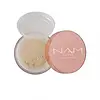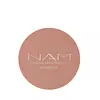What's inside
What's inside
 Key Ingredients
Key Ingredients

 Benefits
Benefits

 Concerns
Concerns

 Ingredients Side-by-side
Ingredients Side-by-side

Montmorillonite
AbsorbentSilica
AbrasiveKaolin
AbrasiveAluminum Starch Octenylsuccinate
AbsorbentMagnesium Stearate
Cosmetic ColorantOctyldodecyl Stearoyl Stearate
EmollientCaprylyl Glycol
EmollientAlumina
AbrasivePhenoxyethanol
PreservativeHdi/Trimethylol Hexyllactone Crosspolymer
Dimethicone/Vinyl Dimethicone Crosspolymer
Skin ConditioningHexylene Glycol
EmulsifyingTriethoxycaprylylsilane
CI 19140
Cosmetic ColorantCI 77492
Cosmetic ColorantCI 15850
Cosmetic ColorantMontmorillonite, Silica, Kaolin, Aluminum Starch Octenylsuccinate, Magnesium Stearate, Octyldodecyl Stearoyl Stearate, Caprylyl Glycol, Alumina, Phenoxyethanol, Hdi/Trimethylol Hexyllactone Crosspolymer, Dimethicone/Vinyl Dimethicone Crosspolymer, Hexylene Glycol, Triethoxycaprylylsilane, CI 19140, CI 77492, CI 15850
Talc
AbrasiveSilica
AbrasiveBoron Nitride
AbsorbentCaprylic/Capric Triglyceride
MaskingMagnesium Stearate
Cosmetic ColorantOctyldodecyl Stearoyl Stearate
EmollientBis-Diglyceryl Polyacyladipate-1
EmollientCaprylyl Glycol
EmollientEthylhexyl Stearate
EmollientPhenoxyethanol
PreservativeHexylene Glycol
EmulsifyingParfum
MaskingTocopheryl Acetate
AntioxidantAlpha-Isomethyl Ionone
PerfumingBenzyl Salicylate
PerfumingCoumarin
PerfumingGeraniol
PerfumingLimonene
PerfumingLinalool
PerfumingCI 77891
Cosmetic ColorantCI 77492
Cosmetic ColorantCI 77491
Cosmetic ColorantCI 77499
Cosmetic ColorantTalc, Silica, Boron Nitride, Caprylic/Capric Triglyceride, Magnesium Stearate, Octyldodecyl Stearoyl Stearate, Bis-Diglyceryl Polyacyladipate-1, Caprylyl Glycol, Ethylhexyl Stearate, Phenoxyethanol, Hexylene Glycol, Parfum, Tocopheryl Acetate, Alpha-Isomethyl Ionone, Benzyl Salicylate, Coumarin, Geraniol, Limonene, Linalool, CI 77891, CI 77492, CI 77491, CI 77499
Ingredients Explained
These ingredients are found in both products.
Ingredients higher up in an ingredient list are typically present in a larger amount.
Caprylyl Glycol is a humectant and emollient, meaning it attracts and preserves moisture.
It is a common ingredient in many products, especially those designed to hydrate skin. The primary benefits are retaining moisture, skin softening, and promoting a healthy skin barrier.
Though Caprylyl Glycol is an alcohol derived from fatty acids, it is not the kind that can dry out skin.
This ingredient is also used as a preservative to extend the life of products. It has slight antimicrobial properties.
Learn more about Caprylyl GlycolCi 77492 is also hydrated iron III oxide. It's sole purpose is to give a yellow hue to products.
Iron III oxides are classified as inorganic chemicals for coloring.
Synthetically created Ci 77492 is considered safer than those naturally found. This is because the synthetically created version may contain less impurities. Iron oxides are generally non-toxic and non-allergenic.
Learn more about CI 77492Hexylene Glycol is a surfactant. Glycols are a class of alcohols. Hexylene Glycol is a surfactant and emulsifier.
As a surfactant, Hexylene Glycol helps gather dirt and oil on your skin to be washed away.
As an emulsifier, Hexylene Glycol helps keep water and oil together. This prevents them from separating in a product. Hexylene Glycol also thins out the texture of a product by lessening viscosity.
Hexylene Glycol has a small molecular weight.
Learn more about Hexylene GlycolMagnesium Stearate is a salt that is 2 parts stearic acid and 1 part magnesium.
It is a white powder that can be used to add bulk and color to products by binding to oil ingredients.
Octyldodecyl Stearoyl Stearate is created from stearic acid.
It is an emollient and thickens the lipid (oil) portion of a product. Due to its emollient properties, it may not be fungal-acne safe.
Phenoxyethanol is a preservative that has germicide, antimicrobial, and aromatic properties. Studies show that phenoxyethanol can prevent microbial growth. By itself, it has a scent that is similar to that of a rose.
It's often used in formulations along with Caprylyl Glycol to preserve the shelf life of products.
Silica, also known as silicon dioxide, is a naturally occurring mineral. It is used as a fine, spherical, and porous powder in cosmetics.
Though it has exfoliant properties, the function of silica varies depending on the product.
The unique structure of silica enhances the spreadability and adds smoothness, making it a great texture enhancer.
It is also used as an active carrier, emulsifier, and mattifier due to its ability to absorb excess oil.
In some products, tiny microneedles called spicules are made from silica or hydrolyzed sponge. When you rub them in, they lightly polish away dead skin layers and enhance the penetration of active ingredients.
Learn more about Silica